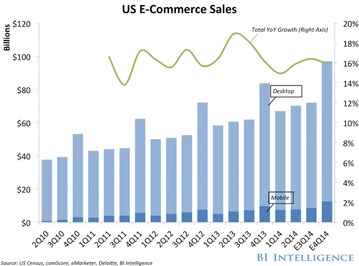Using 3D for online and offline retail
It’s a new year and time for new ideas. You made it through yet another holiday season – and you’re thinking about the next one already.
Your 2015 plan probably includes eCommerce – and even mCommerce. Online retail purchases are growing by double digits year over year, with enormous growth in mobile. ComScore estimated a 16% increase in online sales during the 2014 holiday season.
We also know that online retail influences offline purchases, as consumers research products via Google, Amazon, Wal-Mart, Target, and others. Whether they’re buying online or in-store, shoppers want to have confidence in their purchase. They read reviews, make price and benefit comparisons – and they want to know what it looks like.
Using CGI 3D rendering is one of the most cost-effective ways to let consumers try before they buy. Car manufacturers figured this out early on, and now the majority of car images online are CGI, like this interactive rendering of a Jeep Rubicon. We can preview a car – even one that hasn’t yet left the factory – in different colors, trim packages, and from a myriad of viewing angles. All that’s left is the trip to a dealer to pick up the exact car we choose.
IKEA has been transitioning all of their product photography to CGI over the past few years, and at this point they have an image bank of over 25,000 renderings. According to IKEA, it saves them money because they don’t have to throw away the set after a photo shoot. They can also use the individual CGI renderings as individual catalog product images, or assemble several of them in a 3D landscape to create a room set and light it however they like, whenever they like. Best of all, they can customize the room set for different markets, without needing multiple set builds and multiple photographers.

Image courtesy of Bridge Premedia
Consumer packaged goods are using CGI for both product and package renderings in eCommerce. Here the advantage lies in using a single base model that is re-rendered multiple times to show different flavors or colors available. We can change the viewing angle, lighting, or resolution to fit eCommerce image specifications for multiple retailers – again, using the same base CGI model. Create once and publish everywhere, indeed.
3D renderings let your store buyers and merchandisers try before THEY buy, too. CGI models of a packaged product are often assembled to show pallet displays to club store buyers, or retail ready endcaps to big box retailers. The packaging can be displayed on a shelf set for virtual planogram evaluations.
Finally, think about using 3D renderings for market research. Online focus groups are a cost effective way to evaluate your product early in the development cycle, before it even exists.
Brands are still learning how to leverage omnichannel marketing spends, and many of them are turning to CGI renderings for market research, merchandising planograms, and beauty shots for eCommerce, broadcast, and print. When you need a rendering for any of these applications, CSW Bridge will be ready for you.

Posted by Karen Leet, MarCom Manager
 CSW
CSW
